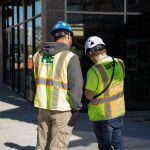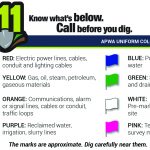
Managing an OSHA Inspection: Before, During and After
Would You Know What to Do if OSHA Shows Up at Your Job Site?
If OSHA knocked on your door today, how would you feel? Would you be concerned or terrified? Or would you be confident? The simple truth is, no one wants to deal with an OSHA inspection. But if you are prepared and knowledgeable, it could mean the difference between terror and confidence.
Here’s a simple explanation of what you can expect from an OSHA inspection (before, during, and after) and some tips for how to be prepared.
Preparation is Your Best Measure . . . BEFORE OSHA Shows Up!
Most likely, you will not receive any advance notice that an inspection is going to occur. Are you prepared should OSHA decide to conduct an inspection on your job site? How do you know if OSHA will inspect your workplace? If you’ve had a recent accident, have had previous citations, or if you know you are one of OSHA’s targeted industries (high-hazard industries or National Emphasis Program), you should assume that you’ll be hearing from OSHA sooner, rather than later.
We’ve known of OSHA inspectors to stop by construction job sites because they happen to be driving by. And with recent emphasis by the Biden Administration to increase vigilance for worker protection, it is expected that OSHA inspections will increase nationwide.
Preparation and knowledge are your best safety compliance measures
OSHA has inspection authority for more than six million job sites nationwide and only a limited number of compliance officers, it has established a system to prioritize it’s choice of sites to inspect.
OSHA’s top priority for inspection is an imminent danger – a situation where workers face an immediate risk of death or serious physical harm. Second priority goes to any fatality or catastrophe – an accident that requires hospitalization of three or more workers.
This system is designed to ensure the maximum feasible protection is provided in the worst situations.
A prioritizes their inspections in the following way:
- Imminent Danger
- Fatality/Catastrophe
- Complaints/Referrals
- Programmed Inspections
It’s important to understand if your job site has had any of these violations which required and inspection and whether you are at risk for further inspections or potential violations and take mitigating measures immediately.
OSHA is At The Door . . . Now What?
First, when an OSHA inspector arrives, they are required to show you their credentials. During the opening conference, they’ll also tell you why the inspection is being completed, the focus or scope of the inspection, and any procedures for the inspection. Be sure management is present before the any physical inspection begins.
During the inspection, the compliance officer will walk around the areas of the facility that fall under the scope of their investigation. They should only visit the locations that were discussed during the opening conference. Don’t offer to take the inspector on a complete tour of the facility unless you are absolutely sure they won’t find any additional violations.
A company representative should accompany the inspector during the walkthrough. Be sure to take notes and pictures just as the inspector will. Answer any questions posed by the inspector, but do not offer any additional information. If simple violations are pointed out by the inspector, correct them immediately. You may still be cited for these violations, but a quick correction shows good faith on your part. OSHA is required to protect any information that is considered a trade secret. If you have any materials/processes that are trade secrets, let the inspector know.
Demonstrate to the inspector that you are genuinely committed to safety in your workplace
Be sure to have any documentation ready that the compliance officer will need. Most likely they will want to see the past few years’ worth of OSHA 300 logs (have at least 5 years’ on file) and your Hazard Communication program. In addition, they will ask to see any other programs or documentation related to the purpose of their visit. They will also want to see the required OSHA poster on the employee or safety bulletin board.
Your overall attitude towards the inspection and inspector will make a difference in the outcome of the inspection. Be cooperative and realize that the inspector is just doing his/her job.
Assessing Your Situation Afterwards
After the walkthrough, the inspector will conduct the closing conference. He or she will explain their findings and give you an idea of what citations you can expect. Your options and path forward will be explained to you. Citations and proposed penalties are issued within 6 months of the inspection.
These citations fall under the following categories (includes approximate penalty amounts)
| Type of Violation | Penalty |
|---|---|
| Serious Other-Than-Serious Posting Requirements | $14,502 per violation |
| Failure to Abate | $14,502 per day beyond the abatement date |
| Willful or Repeated | $145,027 per violation |
Failure to Abate penalties of up to $14,502/day can be assessed if you fail to fix any violations by the abatement date. Penalty amounts are determined based on the gravity of the violation, the size of the business, whether the company has a history of violations, and the company’s good faith to safety.
After you’ve received the letter explaining the citations and proposed penalties, you can ask the area officer for an informal conference to contest violations, attempt to reduce penalty amounts, and/or extend abatement dates. You’ll be expected to make a presentation and describe why you are seeking these changes.
Employee or union representatives are allowed to be at the informal conference. Most likely you will be able to reach a settlement here, but if not and if you still want to contest the citations, you are required to file Notice of Contest within 15 days. Your case is then sent on to a formal review board, the Occupational Safety and Health Review Commission.
Have a Plan. Be Prepared Not Surprised
There are a number of things which you can do to “lessen the pain” of an OSHA inspection. Make sure you have a plan in place and train all employees in what to do when OSHA comes knocking. Know who will accompany the compliance officer throughout the workplace. Make sure employees know what to do if management is not on site at the time of the inspection. Practice your plan regularly.
The number one, most important thing you can do to be prepared for an OSHA inspection is to have a culture of safety in your workplace. If you have a health and safety program in place and it’s instituted in all areas and at all times, then you will have very little to worry about when OSHA arrives.
Practice and be confident in the safety plan you’ve instituted. Look at an OSHA inspection as an opportunity to display your commitment to safety to the OSHA inspector, but also to your employees as well.
Safety is always worth it! Are You Prepared?
You may not look forward to an OSHA inspection, but by being knowledgeable and prepared, you can at least feel confident, rather than terrified! Compliance Consultants has helped many organizations prepare, and plan for any OSHA occurrence. We foster a culture of safety across your organization so all employees are empowered to be part of the safety team.
Contact us today and be prepared for an OSHA inspection.
This information is provided as a service to you by Compliance Consultants, Inc.
Resources:



